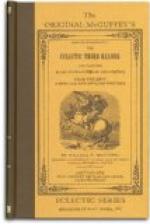When the Fourth Reader was issued in 1837 it contained a preface of three closely printed pages setting forth and defending the plan of McGuffey’s books. In this he said: “In conclusion, the author begs leave to state, that the whole series of Eclectic Readers is his own. In the preparation of the rules, etc., for the present volume he has had the assistance of a very distinguished Teacher, whose judgment and zeal in promoting the cause of education have often been commended by the American people. In the arrangement of the series generally, he is indebted to many of his friends for valuable suggestions, and he takes this opportunity of tendering them his thanks for the lively interest they have manifested for the success of his undertaking.”
The sole author of the four readers first issued as the Eclectic Readers was William Holmes McGuffey. He was responsible for the marked qualities in these books which met with such astonishing popular approval in all these years. What these qualities are is well known to those who have used the books and the users are numbered by millions.
[The Rhetorical Guide]
The Rhetorical Guide was prepared by Mr. A.H. McGuffey, and his name alone was on the early editions. In 1844 the book was revised by the author and Dr. Pinneo, and was given the alternate title “or Fifth Reader of the Eclectic Series.” The work of revision occupied two years. The title page carried the name of its author until, for reasons of his own, he asked to have it removed.
As usual when revisions of schoolbooks are made, the older edition was continued in publication so long as a distinct demand for it existed. But the issuance of a revised edition always suggests the question of change, which competing publishers promptly seek to bring about. The publishers of the “Newly Revised McGuffey Readers,” therefore, sought to replace the older edition wherever it was in use and to displace competing books wherever possible. The edition of 1843 acquired large sales over a very wide territory in the central West and South. It is the edition generally known by the grandfathers of the school boys of the present day.
It may be interesting to name some of the selections in this Rhetorical Guide issued in 1844 since in modified form the work has been the highest reader of the series.
[Selections of Value]
As a guide toward rhetorical reading the book contained a carefully prepared collection of rules and directions with examples for practice in Articulation. Inflection, Accent and Emphasis, Reading Verse, for the Management of the Voice and Gesture. These pages were intended for drill work, and in those days the teachers were not content with the dull monotonous utterance of the words or with mere mastery of thought, to be tested by multitudinous questioning. If the pupil obtained from the printed page the very thought the author intended to convey, the pupil was expected to read orally so as to express that thought to all hearers. If the correct thought was thus heard, no questions were needed. The test of reading orally is the communication of thought by the reader to the intelligent and attentive hearer, and the words of the author carry this message more accurately than can any other words the pupil may select.




